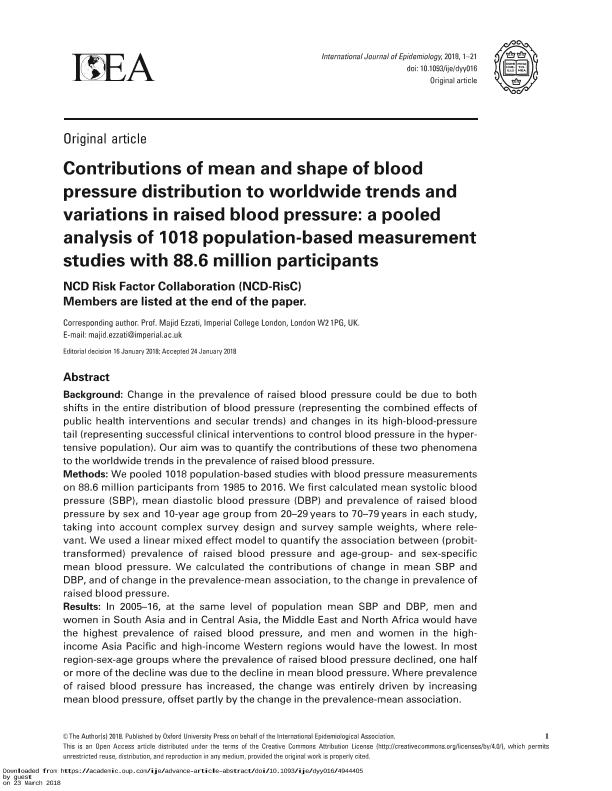Artículo
Contributions of mean and shape of blood pressure distribution to worldwide trends and variations in raised blood pressure: a pooled analysis of 1018 population-based measurement studies with 88.6 million participants
Fecha de publicación:
11/2018
Editorial:
Oxford University Press
Revista:
International Journal of Epidemiology
ISSN:
0300-5771
Idioma:
Inglés
Tipo de recurso:
Artículo publicado
Clasificación temática:
Resumen
Background: Change in the prevalence of raised blood pressure could be due to bothshifts in the entire distribution of blood pressure (representing the combined effects ofpublic health interventions and secular trends) and changes in its high-blood-pressuretail (representing successful clinical interventions to control blood pressure in the hypertensivepopulation). Our aim was to quantify the contributions of these two phenomenato the worldwide trends in the prevalence of raised blood pressure.Methods: We pooled 1018 population-based studies with blood pressure measurementson 88.6 million participants from 1985 to 2016. We first calculated mean systolic bloodpressure (SBP), mean diastolic blood pressure (DBP) and prevalence of raised bloodpressure by sex and 10-year age group from 20?29 years to 70?79 years in each study,taking into account complex survey design and survey sample weights, where relevant.We used a linear mixed effect model to quantify the association between (probittransformed)prevalence of raised blood pressure and age-group- and sex-specificmean blood pressure. We calculated the contributions of change in mean SBP andDBP, and of change in the prevalence-mean association, to the change in prevalence ofraised blood pressure.Results: In 2005?16, at the same level of population mean SBP and DBP, men andwomen in South Asia and in Central Asia, the Middle East and North Africa would havethe highest prevalence of raised blood pressure, and men and women in the highincomeAsia Pacific and high-income Western regions would have the lowest. In mostregion-sex-age groups where the prevalence of raised blood pressure declined, one halfor more of the decline was due to the decline in mean blood pressure. Where prevalenceof raised blood pressure has increased, the change was entirely driven by increasingmean blood pressure, offset partly by the change in the prevalence-mean association.Conclusions: Change in mean blood pressure is the main driver of the worldwide change inthe prevalence of raised blood pressure, but change in the high-blood-pressure tail of thedistribution has also contributed to the change in prevalence, especially in older age groups.
Palabras clave:
EPIDEMIOLOGY
,
BLOOD PRESSURE
Archivos asociados
Licencia
Identificadores
Colecciones
Articulos(CCT - TANDIL)
Articulos de CTRO CIENTIFICO TECNOLOGICO CONICET - TANDIL
Articulos de CTRO CIENTIFICO TECNOLOGICO CONICET - TANDIL
Citación
Diaz, Alberto Alejandro; Contributions of mean and shape of blood pressure distribution to worldwide trends and variations in raised blood pressure: a pooled analysis of 1018 population-based measurement studies with 88.6 million participants; Oxford University Press; International Journal of Epidemiology; 47; 3; 11-2018; 1-21
Compartir
Altmétricas




